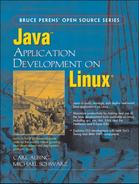We try to wrap this whole thing up, talk about the future, and beg for your help.
Our crystal ball is a bit foggy, though. Linux is a moving target, and so is Java. In a twist of fate that few could have predicted, the Mono project has a .NET development platform for Linux (and, in fact, for most UNIX-like operating systems). Sun has been talking about open-sourcing Java. [1] New languages and tools emerge all the time. Heck, Geronimo popped up during the research and writing of this very book, while JBoss was the first to pass the Compatibility Test Suite for J2EE. Two minor and one major Java release happened during the writing of this book. A major Linux kernel release occurred. Naught endures but mutability. (The only constant is change.)
The three things we can say with confidence are that with Java, Linux, and Open Source, the platform and the tools only get better, the price doesn’t go up, and everyone has the chance to play on an level field.
We wouldn’t dream of predicting the future, but we’re sure that both Linux and Java will have a significant place in it.
This is an Open Content book (as we explained in Preface). You will be able to take it and do with it what you please. We plan to keep improving the book online, and we’d like to invite you all to join in. The authors (who like to refer to themselves in the third person) have the book set up on public servers at http://www.javalinuxbook.com/ and we welcome comments, suggestions, even patch files.
Don’t be afraid to participate. Credit of some sort will be given to every accepted contribution.
A lot of people write about Free Software and Open Source in terms ranging from economic history to political revolutionary rhetoric. One of your present humble authors has even written the phrase “economic inevitability” in a weak moment. And while there is ample room to speculate on the future by looking at the past, and while there actually are legitimate issues of liberty, rights, and politics in the mix, it is always shaky when an argument veers close to tautology (“Free Software is right because it is right”).
Some people will actually choose Free Software for political reasons, just as some Americans chose rebellion for political reasons. But the majority of Americans in 1776 were not revolutionaries, and the majority of people using Linux are not either. We have other concerns. In both cases, keeping bread on the table is a greater concern for most than the revolutionary issue.
Read Richard Stallman’s writings if you are interested in the revolution. Read Lawrence Lessig[2] if you are interested in the politics and legal issues. Most of us, however, will be asking how these technologies can put bread on our table.
The key is lifelong learning. And that is where Open has a distinct advantage. You want to know how it works? Look. There is a lot of good code (and some very bad code) out there, free for the taking, analyzing, and for certain uses. One of the arguments made for closed code is a quality argument. But as programmers who have worked on closed systems, we can tell you that we have seen plenty of bad code out that is closed and proprietary. You just have to look at news about viruses and worms to know that. The point is that Open Source and Free Software are a safer investment. In closed systems there is always pressure to “churn” the APIs so that new OS versions and new development tools can be sold. There is some of that in Free Software too, but you can watch it as it happens, and if a program is your bread and butter, you can participate.
In any revolution, there are the brave and foolhardy rushing to the barricades, banners in hand. But the sensible are keeping their heads down and trying to figure out how to get through it all. We hope our modest contribution helps the latter.
This is a book about writing Java applications on Linux systems. We hope we’ve given you enough to get started, and pointed you to some tools and techniques that, while they’ve been around a while, may not all be well known or documented.
We’ve said it before, but each of our chapters tried to cover in a small space what really takes volumes. Our aim has been to give you a flavor, and a start, and a direction.
This book that you are reading is part of the Bruce Perens’ Open Source Series, “a definitive series of Linux and Open Source books” according to the publisher Prentice Hall PTR; and who are we to disagree? Seriously though, we encourage you to check out any or all of the titles in the series.
We have already mentioned the more philosophical works by Stallman and by Lessig. As a final reference we offer one that covers not the political philosophy of Open Source but the practical philosophy of what makes Linux so successful. It’s called Linux and the UNIX Philosophy by Mike Gancarz, published by Digital Press (ISBN 1555582737). It gives practical examples of the way Linux does things, which makes it so useful, so usable, and so enduring. If you’re going to be developing on Linux, we encourage you to read it. It is easier to swim with the tide, and understanding the design approaches behind Linux will give you that advantage.
[1] And may we drop all pretense of objectivity and say “Go, Sun! Go! Open it up!”
[2] A Stanford Law School professor and founder of the Center for Internet and Society, Lessig is the author of three remarkable books: Code and Other Laws of Cyberspace, The Future of Ideas: The Fate of the Commons in a Connected World, and Free Culture: How Big Media Uses Technology and the Law to Lock Down Culture and Control Creativity.
